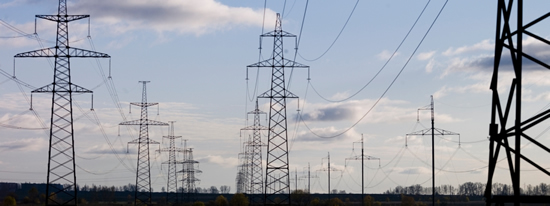National Grid - Electricity Distribution
Electricity is carried around the country by the National Grid. Pylons carry the electrical energy in cables from the power station to the towns, so the consumer can make use of it. Electricity transmission lines provide the 'transport highways' that move electricity from the generation sources (power stations) to concentrated areas of customers (towns and cities). From there, the distribution system moves the electricity to where the customer uses it at a business or home. Transmission systems are unique because they are designed to move this energy at the speed of light from the generator to the consumer since there is no long-term storage capability for electricity. Electricity, when transmitted, flows over all available paths to reach the customer and it cannot be easily directed in one particular way. Therefore, the buying and selling of electricity requires careful co-ordination and monitoring of the electrical systems. If a problem develops somewhere it can affect other operations elsewhere. After electricity is produced at power plants it has to get to the customers that use the electricity to make their life easier. The country is criss-crossed with power lines that "carry" the electricity. Large generators spin producing electricity with a voltage of about 25 kV. Transmission across the country at a high voltage to cut energy lossThe electricity goes to a transformer at the power plant that boosts the voltage up to a high value. Power is the product of current and voltage. The same electrical power can be transmitted at high voltage and low current or as at low voltage and high current because: P = IV However, power loss due to heat energy in the wires is given by the equation: P = I2R so by keeping current low heat produced in the wires is reduced. As there is less energy loss to the atmosphere as heat energy when transmitted at high voltages, the electricity is sent across the country at 275kV and 400kV. Dangerous voltages - but efficient! The long thick cables of transmission lines are made of copper or aluminum because they have a low resistance. This also cuts down on loss of energy as heat to the surroundings. Votage is stepped down before it reaches the consumerThe power lines go into substations near businesses, factories and homes. Transformers are also used at the this end of the journey to bring the voltage down to 230V for domestic use. When electricity enters your home, it must pass through a meter. Either a utility company worker reads the meter, or you have a smart meter that sends the readings automatically so the company knows how much electricity you used and can 'bill you' for the cost.
After being metered, the electricity goes through a fuse box into your home. The fuse box protects the house in case of problems. When a fuse "blows" or a circuit
breaker "trips" something is wrong with
an appliance or something was short-circuited. Electricity production summary:
|
Follow me...
|







